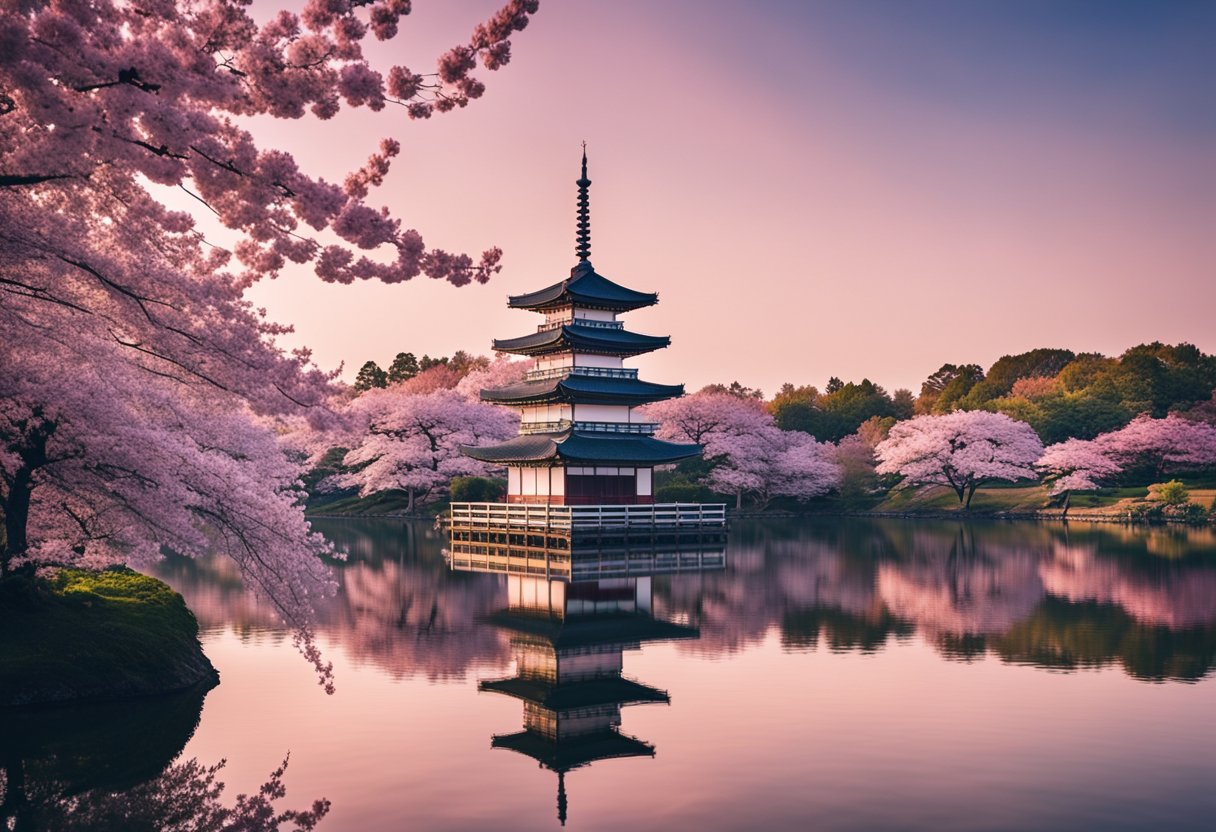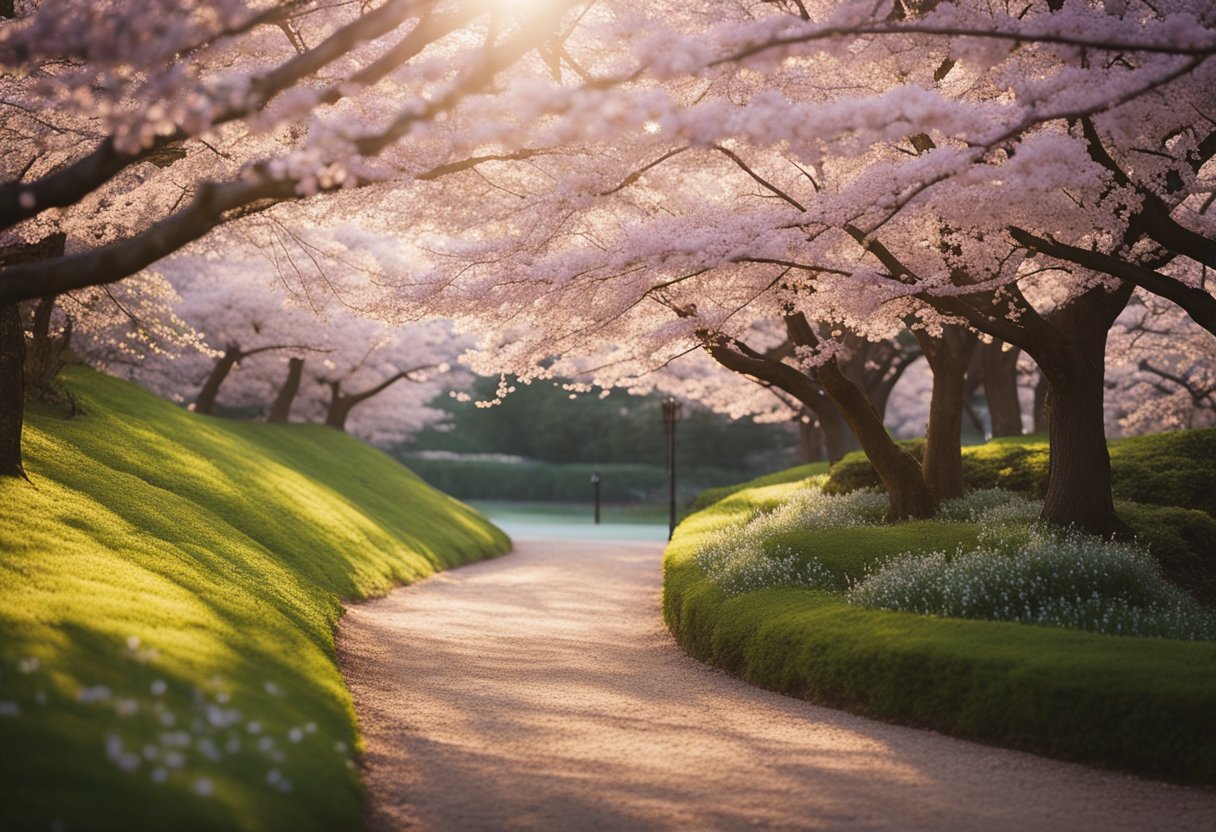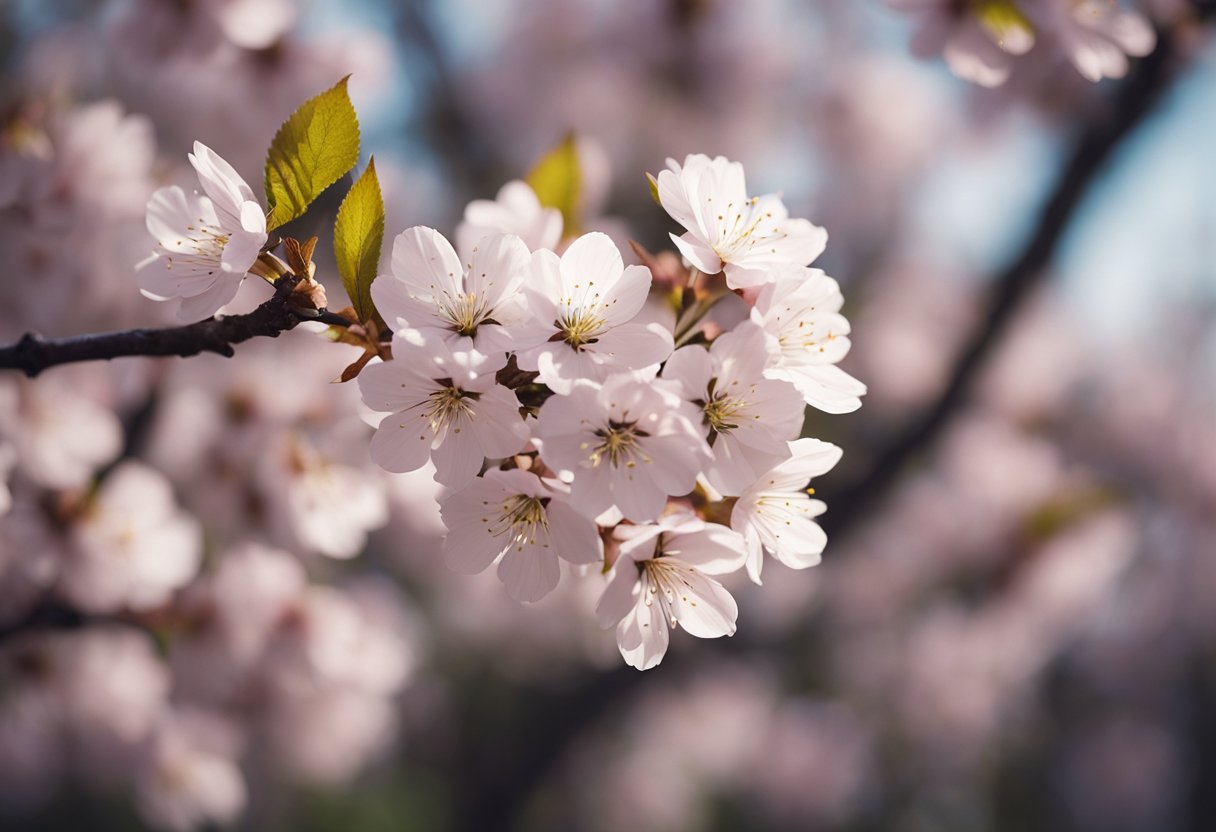The Cherry Blossoms of Japan: Unveiling their Ethereal and Fleeting Elegance

Updated On: April 22, 2024 by Maha Yassin
As the petals of sakura, or cherry blossoms, unfold across Japan, they bring a wave of beauty and a reminder of the transient nature of life. Celebrated within Japanese culture, these blossoms are more than just a natural spectacle—they hold profound symbolism and are a central theme in many aspects of Japanese tradition and philosophy. Each year, the arrival of cherry blossoms marks a time of renewal and contemplation, inspiring festivities and reflection.
The practice of hanami, the cherry blossom viewing, is an enduring custom that invites us to pause and absorb the transient beauty around us. The delicate life of cherry blossoms, a dance of pink and white against the spring sky, encourages a philosophical approach to the cycles of life and nature. While these blossoms bloom brilliantly for a short while, their fleeting presence is deeply interwoven with Japan’s aesthetic values and social interactions, bridging the past and present with every petal.
The Cherry Blossoms in Japanese Culture
The cherry blossom, or sakura, is deeply entrenched in Japanese culture, symbolising life’s beauty and transient nature. It inspires numerous customs and profoundly affects cultural expressions, from art and poetry to music and festivals.
Cherry Blossoms and Hanami Traditions
Hanami is the centuries-old practice of celebrating the seasonal blooming of cherry blossoms. We gather under the blooming sakura for picnics and parties, embracing the beauty of these fleeting flowers. At its core, hanami is a time for us to reflect on the ephemeral nature of life, encapsulated by the Japanese concept of mono no aware, a sensitivity to the transient nature of things.
Symbolism in Art and Literature
Cherry blossoms hold significant symbolism in Japanese art and literature, embodying aesthetic and symbolic meanings. Poets and artists have long been inspired by Sakura, which is prominently featured in the ancient poetry anthology Manyoshu. The blossoms’ beauty and quick demise are seen as a metaphor for life itself—breathtaking yet transient.
The Influence of Sakura on Festivals and Music
Cherry blossoms have shaped countless festivals, resonating through Japanese culture with events dedicated to their viewing. Transient and delicate, they often influence traditional Japanese music, where the sakura’s themes are interpreted subtly and deeply. The blossoms are more than a natural spectacle; they weave into the cultural fabric, marking the rhythm of seasons and songs.
Historical Significance of Cherry Blossoms
In exploring the historical significance of cherry blossoms in Japan, it is essential to recognise their deep-rooted influence on Japanese culture, embodying beauty and the ephemeral nature of life.
Sakura in Ancient Japan
In Japan, the celebration of cherry blossoms, or sakura, dates back to the Nara Period when they were revered for their delicate beauty. Initially, the elite of Japanese society admired plum blossoms, but by the Heian Period, the focus shifted to sakura. Festivities involved picnicking under the blooming trees, a tradition known as hanami, which has continued through the centuries.
Cherry Blossoms During and After World War II
During and after World War II, cherry blossoms took on additional significance for Japan. They were used to promote patriotism and as a metaphor for the kamikaze pilots, who were likened to the brief and brilliant life of the blossoms. The stubborn spirit embodied by the samurai resonated through this symbolism, invoking bushido ideals such as honour, courage, and the fleeting nature of life.
From Samurai to Modern Day: Cherry Blossoms and Bushido
From the samurai era to our modern day, the ethos of bushido, the warrior’s way, has been intricately associated with cherry blossoms. These flowers have symbolised the virtues of bushido, such as the readiness to face death with honour, mirroring the samurai’s acceptance of the transient nature of existence. Today, cherry blossoms remain a potent emblem, reminding us of our shared heritage and the timeless principles underpinning Japanese culture.
Philosophy and Cherry Blossoms
In Japan, the fleeting beauty of cherry blossoms carries deep philosophical significance, embodying the concepts of mono no aware and wabi-sabi, which celebrate the transience and imperfection of life.
Mono No Aware and the Beauty of Ephemerality
Mono no aware is a Japanese term that translates to “the pathos of things,” highlighting the acute awareness of impermanence in beauty and life. Cherry blossoms, or sakura, are an embodiment of this philosophy. Their brief but breathtaking bloom represents the ephemeral nature of existence, reminding us to cherish moments fleeting in time.
Wabi-Sabi and the Acceptance of Imperfect Beauty
Wabi-sabi is a worldview centred on the acceptance of transience and imperfection. Through the lens of cherry blossoms, this concept manifests as an appreciation for the asymmetric and incomplete. As petals fall, they mirror the beauty found in the impermanence and flaws of life, teaching us to embrace the natural cycle of growth and decay.
Cherry Blossoms as a Metaphor
With their fleeting beauty, cherry blossoms are a powerful metaphor for life’s temporary nature and the cycle of life and death.
Life, Death, and Renewal
The cherry blossom, or sakura, epitomises the fragility and beauty of life. In Japan, it is not uncommon to witness the hanami tradition, where people engage in flower viewing that reminds us of life’s transient beauty. As the blossoms flourish and then swiftly fall, they metaphorically represent our mortality, urging us to reflect upon the impermanence of our existence. Yet, these flowers symbolise renewal as their annual bloom heralds the arrival of spring, a season of new beginnings and rejuvenation.
Sakura as a Representation of Human Existence
Symbolically, cherry blossoms capture the essence of our human existence. Like the sakura, our lives are fleeting and fragile, meriting appreciation for each moment in the present. To contemplate cherry blossoms is acknowledging the profound cycle of life, death, and rebirth. Through the lens of these delicate blossoms, we recognise our human experience, marked by brief yet brilliant moments that, like the petals, must one day fall, paving the way for the next season of life.
Cycles of Cherry Blossoms

In Japan, the cherry blossoms, also known as sakura, are deeply integrated into the natural and cultural landscape, marking a cyclical event that captures the essence of beauty and transience. Every spring, these trees go through a dynamic, eagerly anticipated, and meticulously observed process.
Bloom Tracking and Peak Bloom Periods
We meticulously track the progress of the cherry blossoms, from the initial budding to the much-awaited full bloom. When most of the sakura trees are in full bloom, the peak bloom is a fleeting spectacle that lasts only about one to two weeks. Meteorological agencies and enthusiasts closely monitor temperature patterns, crucial in predicting the peak bloom period. Typically, the bloom commences in the southern regions of Japan and moves northward as the warmer spring temperatures spread across the archipelago.
Understanding the Transience of Sakura’s Beauty
The temporary nature of cherry blossoms is at the heart of their allure. Their brief appearance is a powerful reminder of the transient nature of life, a concept deeply embedded in Japanese culture. The full bloom is a transient state, a pinnacle of beauty that soon gives way as the blossoms gracefully fall. This brief period of full bloom encapsulates a poignant beauty that resonates with the spirit of spring, a time of renewal and reflection.
By engaging with the cycles of cherry blossoms, we partake in a seasonal ritual that celebrates life’s impermanent yet cyclical nature, revealing a profound connection between our existence and the natural world.
The Aesthetic of Cherry Blossoms
As we observe the cherry blossoms of Japan, their aesthetic value cannot be overstated. From the visual impact of their delicate pink petals to their inspiration in art and design, cherry blossoms encapsulate beauty and fragility in equal measure.
The Visual Splendour of Cherry Blossoms
The sight of cherry blossoms in full bloom is one of remarkable beauty. Their pink petals represent a spectrum of shades, from pale blush to vibrant rose, creating a breathtaking floral landscape. This seasonal phenomenon, known as sakura, is a feast for the eyes and a symbol of life’s wonder and fragility. The blossoms appear en masse, transforming trees into clouds of colour and the ground below into a petal-strewn tapestry. Their ephemeral nature serves as a poignant reminder that such splendour is fleeting, much like the beauty in life’s transient moments.
Influence on Aesthetics and Design
In art and design, cherry blossoms have long been a source of inspiration. Sakura motifs are prevalent in various artistic expressions, including traditional kimonos, contemporary graphic designs, and even intricate tattoo artistry. With their delicate and transient nature, the wonder of these blossoms has influenced aesthetic principles that value subtlety and impermanence. Art inspired by cherry blossoms often captures not only their physical beauty but also their cultural significance. They bring a sense of organic elegance to objects and spaces in design, reminding us of nature’s timeless artistry.
Cherry Blossom Celebrations in Japan and Worldwide
The arrival of cherry blossoms, known as sakura, ushers in a time of celebration both in Japan and across the globe. These festivities reflect the beauty of Japanese cherry blossoms, their significance in culture and the fleeting nature of life.
Hanami: Cherry Blossom Viewing Experience
Hanami is the traditional Japanese practice of viewing cherry blossoms, a celebration dating back centuries. In cities like Tokyo and Kyoto, locals and tourists gather under the blooming sakura for picnics and parties. Amidst the gentle flurry of pink petals, people commemorate the transience of beauty, reflecting the transient nature of life itself. These gatherings can range from quiet appreciation within serene parks to festive atmospheres with various food and drinks.
International Cherry Blossom Festivals
Internationally, the captivation with cherry blossoms has taken root in various countries. Inspired by Japanese culture, cities worldwide host cherry blossom festivals, bringing together communities to marvel at the blossoms’ beauty. These festivals often feature a mix of cultural presentations, including music, dance, and art installations, celebrating the cherry blossom’s symbolism. Washington, D.C., for example, is renowned for its National Cherry Blossom Festival. This vibrant event celebrates the friendship between Japan and the United States, symbolised by the sakura trees that line the Tidal Basin.
Socio-cultural Role of Cherry Blossoms

In Japan, cherry blossoms, or sakura, are deeply interwoven with the nation’s cultural and social fabric. These blossoms mark an important time of year that combines various facets of Japanese life, from education and community to travel and tourism.
Cherry Blossoms in Education and Community Involvement
In Japanese schools, cherry blossoms herald the start of a new academic year, symbolising new beginnings and the fleeting nature of childhood. Educational institutions often align their schedules with the Sakura season, using this period to welcome students and foster a sense of community.
Local communities actively participate in conservation efforts, planting new trees and organising clean-up events in parks. This involvement emphasises the cherry blossoms’ role in environmental education and reinforces the communal spirit, with residents working alongside one another to maintain the beauty of their shared natural spaces.
Cherry Blossoms and Tourism
Each year, the bloom of cherry blossoms transforms tourist activity in Japan. Travellers plan their itineraries around the fleeting Sakura season, eager to witness these blossoms’ breathtaking scenery. This has led to a significant seasonal industry, with hotels, guides, and retailers catering to the influx of visitors eager to participate in cherry blossom viewings known as hanami.
Tourist hotspots, particularly parks and historic sites known for their sakura trees, leverage this time to showcase Japanese culture and history. Such events encourage cultural exchange and present opportunities for visitors to engage with local traditions and embrace the ethos of transient beauty that cherry blossoms represent.
Cherry Blossoms Beyond Japan

While cherry blossoms are synonymous with Japan, their influence and aesthetic appeal have transcended borders, resonating with people across various cultures globally.
The Global Spread of Cherry Blossom Beauty
The enchanting spectacle of cherry blossoms has found its way beyond the confines of Japan to regions across the globe. In the United States, the famous National Cherry Blossom Festival in Washington, D.C., celebrates the enduring friendship between Japan and the U.S., marked by the gift of cherry trees in 1912. Visitors are enthralled by the stunning bloom of these trees every spring.
Across Asia, particularly in South Korea, cherry blossoms symbolise renewal and the fleeting nature of life. The annual Yeouido Spring Flower Festival in Seoul showcases these beautiful blooms, and locals and tourists partake in the joyful viewing known as “hanami” in Japan. In China, the cherry blossom signifies feminine beauty and power, a testament to its cultural significance that extends well beyond its home country.
Cross-cultural Exchanges Through Sakura
As cherry blossoms are known in Japanese, Sakura has facilitated cross-cultural exchanges. The blossoms’ integration into various cultures reflects a shared appreciation for nature’s delicate yet transient beauty. India, with its diverse cultural fabric, has incorporated cherry blossoms into its mosaic, with places such as the Indian state of Meghalaya celebrating their cherry blossom festivals. These cultural exchanges through Sakura foster a sense of global connection as we reflect on the cherry blossoms’ symbolism of the passing of time and the importance of living in the present.
Cherry Blossom Inspired Practices
In Japan, cherry blossoms, or sakura, inspire traditions that bring people closer to nature and community. These practices are deep-rooted in Japanese culture and are celebrated with great enthusiasm.
Tea Ceremonies and Picnics Under Sakura
During the cherry blossom season, holding outdoor tea ceremonies and picnics becomes an essential ritual for many. Families, friends, and colleagues gather beneath the blooming sakura for hanami, which means “flower viewing”. This cherished practice involves laying out picnic sheets and enjoying food and drink while admiring the beauty of the cherry blossoms. It’s a time for celebration and reflection, with parks and gardens becoming vibrant hubs of social interaction.
Horticultural Practices and Cherry Blossom Varieties
Our expertise in horticulture shines through in the careful cultivation of various cherry blossom trees. Across gardens and parks throughout Japan, horticulturists aim to create breathtaking displays, and there’s an appreciation for the different varieties of sakura trees. Each type, from the popular Somei Yoshino with its pure white blossoms to the Shidarezakura, or weeping cherry, offers a different aesthetic to admirers. The meticulous care given to nurturing these trees reflects our devotion to the sakura, ensuring that this symbol of transient beauty endures for generations to celebrate.
FAQs
In this section, we address some of people’s most common queries regarding cherry blossoms’ cultural and spiritual essence in Japan.
What is the historical significance of cherry blossoms in Japan?
Cherry blossoms, or sakura, have been celebrated in Japan for centuries. Historically, they are connected to the nation’s agricultural roots, signalling the rice-planting season and embodying the spirit of the samurai due to their fleeting nature mirroring the life of a warrior.
How are cherry blossoms symbolically used in Japanese culture?
In Japanese culture, cherry blossoms represent life’s beauty and ephemeral nature. They appear in various art forms, including poetry and painting, symbolising the delicate balance between life’s vibrant moments and transient nature. Celebrations like hanami and the cherry blossom viewing festival underscore their cultural importance.
In what ways do cherry blossoms represent the concept of transience?
Due to their short blooming period, cherry blossoms are a poignant metaphor for transience. This brevity reflects the Japanese concept of ‘mono no aware’, the heightened appreciation for the fleeting beauty of the natural world, reminding us of the impermanence and fragility of life.
What meanings are commonly associated with cherry blossom tattoos?
Cherry blossom tattoos often symbolise the beauty of existence and the preciousness of life. They can serve as a reminder to live fully and appreciate each moment, acknowledging the transient nature of our existence.
How is the concept of love expressed through cherry blossoms?
Cherry blossoms convey love nuancedly, illustrating love’s intensity and fleeting moments. In Japan, the bloom is akin to a reminder that while love can be breathtakingly beautiful, it is often temporary, making it crucial to embrace it wholeheartedly.
What spiritual significance do cherry blossoms hold?
Spiritually, cherry blossoms signify rebirth and moral purity in Japanese culture. Their springtime arrival represents a time for renewal and optimism, encouraging us to start afresh with each passing season.






